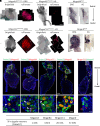MrgprC11+ Jugular Neurons Control Airway Hyperresponsiveness in Allergic Airway Inflammation
- PMID: 39405479
- PMCID: PMC12005045
- DOI: 10.1165/rcmb.2024-0153OC
MrgprC11+ Jugular Neurons Control Airway Hyperresponsiveness in Allergic Airway Inflammation
Abstract
The lung is densely innervated by sensory nerves, the majority of which are derived from the vagal sensory neurons. Vagal ganglia consist of two different ganglia, termed nodose and jugular ganglia, with distinct embryonic origins, innervation patterns, and physiological functions in the periphery. Because nodose neurons constitute the majority of the vagal ganglia, our understanding of the function of jugular nerves in the lung is very limited. This study aims to investigate the role of MrgprC11+ jugular sensory neurons in a mouse allergic asthma model. Our previous study has shown that MrgprC11+ jugular neurons mediate cholinergic bronchoconstriction. In this study, we found that, in addition to MrgprC11, several other Mrgpr family members, including MrgprA3, MrgprB4, and MrgprD, are also specifically expressed in the jugular sensory neurons. MrgprC11+ jugular neurons exhibit dense innervation in the respiratory tract, including the larynx, trachea, proximal bronchus, and distal bronchus. We also found that receptors for IL-4 and oncostatin M, two critical cytokines promoting allergic airway inflammation, are mainly expressed in jugular sensory neurons. Both IL-4 and oncostatin M can sensitize the neuronal responses of MrgprC11+ jugular neurons. Moreover, ablation of MrgprC11+ neurons significantly inhibited airway hyperresponsiveness in the asthmatic lung, demonstrating the critical role of MrgprC11+ neurons in controlling airway constriction. Our results emphasize the critical role of jugular sensory neurons in respiratory diseases and present MrgprC11+ neurons as a potential therapeutic target for treating airway hyperresponsiveness.
Keywords: airway hyperresponsiveness; allergic asthma; jugular neurons; neuroimmune interactions; vagal sensory neurons.
Figures







Comment in
-
Cracking the Code of the Jugular Vagal Sensory Neurons in Allergic Airway Responsiveness.Am J Respir Cell Mol Biol. 2025 Apr;72(4):346-348. doi: 10.1165/rcmb.2024-0445ED. Am J Respir Cell Mol Biol. 2025. PMID: 39471332 Free PMC article. No abstract available.
References
MeSH terms
Substances
Grants and funding
LinkOut - more resources
Full Text Sources
Medical

